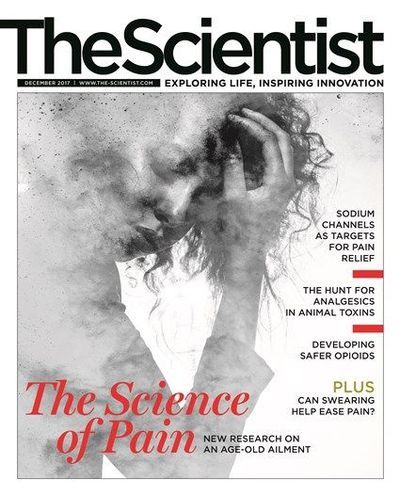Login
SubscribeFeatures

Targeting Sodium Channels for Pain Relief
Catherine Offord | Jan 1, 2018 | 10+ min read
The race to develop analgesic drugs that inhibit sodium channel NaV1.7 is revealing a complex sensory role for the protein.

Glial Ties to Persistent Pain
Mark R. Hutchinson | Jan 1, 2018 | 10 min read
Immune-like cells in the central nervous system are now recognized as key participants in the creation and maintenance of persistent pain.

Animal Analgesics
The Scientist | Jan 1, 2018 | 3 min read
A cornucopia of toxins in the animal kingdom could provide inspiration for novel painkillers, but so far, effective drugs have proven elusive.

Novel Analgesics at a Snail’s Pace
Bob Grant | Jan 1, 2018 | 3 min read
Studying cone snail venom has yielded novel pain pathways, but the peptides that function as toxins are difficult to translate into drugs.

Researchers Mine Centipede Toxins for Analgesics
Catherine Offord | Jan 1, 2018 | 1 min read
Venomous centipedes may harbor a clue to the creation of a successful pain-killing compound for humans.

Mining Spider Toxins for Analgesic Clues
Catherine Offord | Jan 1, 2018 | 2 min read
Arachnids harbor a plentiful array of molecules that target mammalian pain receptors.

Toxin from a Dangerous Fish Delicacy
Kerry Grens | Jan 1, 2018 | 2 min read
In tiny doses, the pufferfish’s tetrodotoxin can be turned into a pain-relieving ion channel blocker.

Sourcing Painkillers from Scorpions’ Stings
Abby Olena, PhD | Jan 1, 2018 | 2 min read
Compounds in the arachnids’ venom interact with ion channels to both cause and block pain.

Sea Anemone Toxin Could Treat Autoimmunity
Jef Akst | Jan 1, 2018 | 2 min read
If successful, the treatments could alleviate patients’ pain by reducing inflammation.

Frog Skin Yields Potent Painkillers, but None Clinic Ready
Shawna Williams | Jan 1, 2018 | 2 min read
Decades after their discovery by bioprospectors, amphibian-derived analgesics continue to attract scientific attention.

Snake Venoms Cause and Block Pain
Kerry Grens | Jan 1, 2018 | 2 min read
Painful snake bites may hold clues to developing analgesic drugs.
Reading Frames
Book Excerpt from Swearing is Good for You
Book Excerpt from Swearing is Good for You
In chapter 1, “The Bad Language Brain: Neuroscience and Swearing,” author Emma Byrne sets the scene for her book by telling the story of the hapless and potty-mouthed Phineas Gage.
Why Swearing and Pain Go Hand in Hand
Why Swearing and Pain Go Hand in Hand
Screaming obscenities when you stub your toe makes perfect biological sense.
Contributors
Contributors
Contributors
Meet some of the people featured in the January 2018 issue of The Scientist.
Editorial
Prizes and Penalties
Prizes and Penalties
Life is filled with pleasure and pain. Science and society are struggling mightily with both.
Speaking of Science
Ten-Minute Sabbatical
Ten-Minute Sabbatical
Take a break from the bench to puzzle and peruse.
Freeze Frame
Caught on Camera
Caught on Camera
Selected Images of the Day from the-scientist.com
Notebook
What Bat Quarrels Tell Us About Vocal Learning
What Bat Quarrels Tell Us About Vocal Learning
New research shows humans aren’t that different from our winged cousins.
Sex Differences in Opioid Analgesia: A Complicated Picture
Sex Differences in Opioid Analgesia: A Complicated Picture
Researchers are beginning to tease apart the mechanisms underlying differences in how males and females respond to powerful painkillers.
Researchers Team Up with Patients to Build a Breast Cancer Database
Researchers Team Up with Patients to Build a Breast Cancer Database
Combining genomic, clinical, and patient-reported data, the Metastatic Breast Cancer Project provides a unique resource for the cancer community.
Mothers Are Hard-Wired to Respond Similarly to Infant Cries Across Cultures
Mothers Are Hard-Wired to Respond Similarly to Infant Cries Across Cultures
Researchers find consistent behaviors and brain activity in an international study.
Online First
Child Receives Transgenic Skin
Child Receives Transgenic Skin
A combination gene-and-cell therapy has given a boy with a grievous skin disease a new lease on life, and resolved a dermatology debate to boot.
Modus Operandi
3-D–Printed Ethoscopes Lower Barriers to Large-Scale Fly Behavior Studies
3-D–Printed Ethoscopes Lower Barriers to Large-Scale Fly Behavior Studies
The DIY devices collect data and enable light stimulation, chamber agitation, and gas infusion.
The Literature
Distinct Regions Drive Responses to Anxiety, Fear
Distinct Regions Drive Responses to Anxiety, Fear
Researchers map brain activity associated with a person’s anticipation of or direct confrontation with danger.
Skin “Remembers” Wounds, Heals Faster the Second Time Around
Skin “Remembers” Wounds, Heals Faster the Second Time Around
After an initial wounding, genes needed for repair remain ready for action.
Linoleic Acid Derivatives Potentially Mediate Pain and Itch in the Skin
Linoleic Acid Derivatives Potentially Mediate Pain and Itch in the Skin
Researchers uncover a family of compounds that may be involved in pain transmission.
Profile
David Julius Probes the Molecular Mechanics of Pain
David Julius Probes the Molecular Mechanics of Pain
For nearly 30 years, the UC San Francisco researcher has delved into unexplored corners of the nervous system.
Scientist to Watch
Annina Schmid Dissects Nerve Disorders
Annina Schmid Dissects Nerve Disorders
A background in physiotherapy helps the Oxford-based researcher mix basic science with clinical work to better understand pain stemming from nerve compression.
Lab Tools
High-Throughput Epigenetics Analyses
High-Throughput Epigenetics Analyses
Emerging technologies help researchers draw mechanistic links between metabolism and epigenetic modification of DNA.
Bio Business
The Quest for Safer Opioid Drugs
The Quest for Safer Opioid Drugs
From basic research in academic labs to Phase 3 clinical trials, myriad efforts are underway to divorce opioids' pain-relieving potential from their undesirable downsides.
Foundations
Fake News: Mars Edition, circa 1877
Fake News: Mars Edition, circa 1877
Giovanni Schiaparelli’s maps of Mars sparked the belief that intelligent life exists on the planet.




















